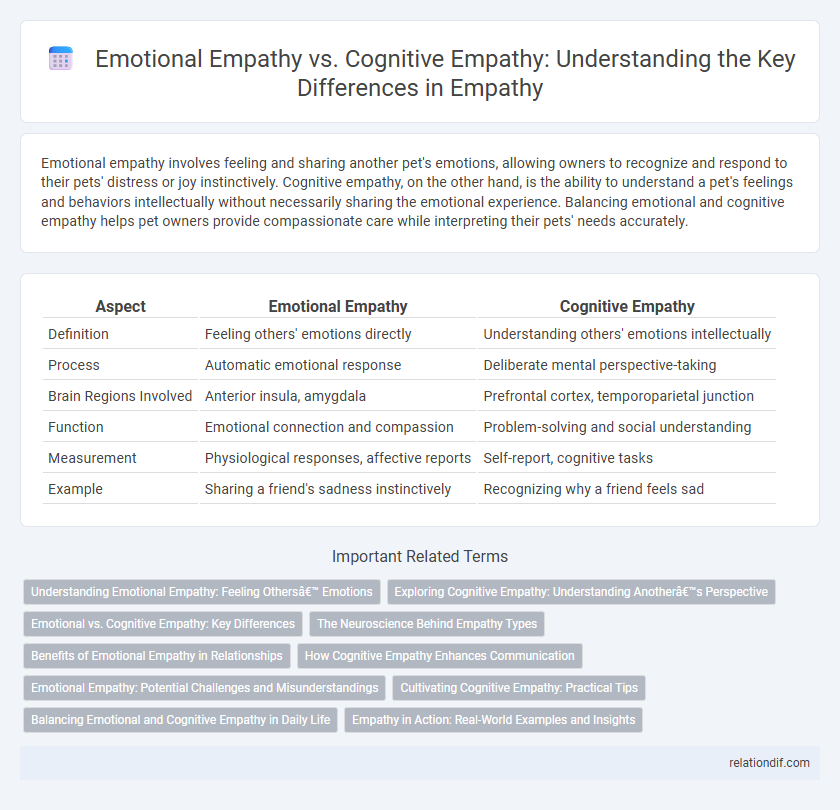Emotional empathy involves feeling and sharing another pet's emotions, allowing owners to recognize and respond to their pets' distress or joy instinctively. Cognitive empathy, on the other hand, is the ability to understand a pet's feelings and behaviors intellectually without necessarily sharing the emotional experience. Balancing emotional and cognitive empathy helps pet owners provide compassionate care while interpreting their pets' needs accurately.
Table of Comparison
| Aspect | Emotional Empathy | Cognitive Empathy |
|---|---|---|
| Definition | Feeling others' emotions directly | Understanding others' emotions intellectually |
| Process | Automatic emotional response | Deliberate mental perspective-taking |
| Brain Regions Involved | Anterior insula, amygdala | Prefrontal cortex, temporoparietal junction |
| Function | Emotional connection and compassion | Problem-solving and social understanding |
| Measurement | Physiological responses, affective reports | Self-report, cognitive tasks |
| Example | Sharing a friend's sadness instinctively | Recognizing why a friend feels sad |
Understanding Emotional Empathy: Feeling Others’ Emotions
Emotional empathy involves the direct experience of another person's feelings, allowing individuals to truly sense and resonate with the emotions observed. This form of empathy activates brain regions such as the anterior insula and anterior cingulate cortex, which are associated with emotional processing and pain perception. Understanding emotional empathy enhances interpersonal connections by fostering genuine emotional sharing and compassion.
Exploring Cognitive Empathy: Understanding Another’s Perspective
Cognitive empathy involves the ability to intellectually grasp another person's thoughts, feelings, and intentions without necessarily sharing their emotions. This perspective-taking skill enhances communication, conflict resolution, and social interactions by enabling individuals to anticipate and respond appropriately to others' needs. Developing cognitive empathy fosters greater understanding and cooperation in both personal and professional relationships.
Emotional vs. Cognitive Empathy: Key Differences
Emotional empathy involves directly feeling another person's emotions, allowing for a deep, instinctive connection that often triggers an automatic emotional response. Cognitive empathy, on the other hand, is the ability to understand and intellectually process another person's feelings without necessarily sharing the emotional experience. Key differences lie in emotional empathy's focus on affective resonance and shared experience, while cognitive empathy emphasizes perspective-taking and mental awareness of others' emotions.
The Neuroscience Behind Empathy Types
Emotional empathy activates the mirror neuron system, enabling individuals to physically feel others' emotions, while cognitive empathy engages the prefrontal cortex for understanding others' perspectives without necessarily sharing their feelings. Neuroscientific studies reveal that emotional empathy relies on the amygdala and insula for affective processing, whereas cognitive empathy involves the temporoparietal junction and medial prefrontal cortex for theory of mind functions. These distinct neural pathways illustrate how emotional and cognitive empathy complement each other in social cognition and interpersonal relationships.
Benefits of Emotional Empathy in Relationships
Emotional empathy enables deeper emotional connections by allowing individuals to genuinely feel and share others' emotions, fostering trust and intimacy in relationships. This empathetic resonance promotes effective communication and conflict resolution by validating feelings and encouraging mutual understanding. Enhanced emotional empathy contributes to stronger social bonds and increased emotional support, essential for relationship satisfaction and stability.
How Cognitive Empathy Enhances Communication
Cognitive empathy enhances communication by allowing individuals to understand others' perspectives and thought processes without necessarily sharing their emotions. This ability to accurately interpret intentions and feelings improves clarity, reduces misunderstandings, and fosters more effective dialogue. By leveraging cognitive empathy, communicators can tailor their responses to address the specific concerns and viewpoints of their audience.
Emotional Empathy: Potential Challenges and Misunderstandings
Emotional empathy involves directly sharing and feeling another person's emotions, which can lead to emotional overload or burnout, especially in high-stress environments like healthcare or counseling. Misunderstandings arise when individuals assume emotional empathy requires sympathy, potentially causing blurred boundaries and reduced objectivity. Effective emotional empathy demands balanced self-awareness to prevent compassion fatigue while maintaining genuine connections.
Cultivating Cognitive Empathy: Practical Tips
Cultivating cognitive empathy involves actively developing the ability to understand another person's perspective and thought processes through deliberate practice and reflection. Techniques such as engaging in perspective-taking exercises, practicing active listening, and asking open-ended questions enhance one's capacity to accurately interpret others' intentions and emotions. Regular mindfulness practices and empathy-building activities foster mental flexibility, enabling deeper cognitive connection and improved interpersonal communication.
Balancing Emotional and Cognitive Empathy in Daily Life
Balancing emotional and cognitive empathy in daily life enhances interpersonal connections by integrating heartfelt understanding with rational perspective-taking. Emotional empathy allows individuals to deeply feel others' emotions, while cognitive empathy facilitates recognizing and interpreting those feelings objectively. Cultivating both forms of empathy fosters effective communication, reduces conflicts, and supports compassionate decision-making in diverse social situations.
Empathy in Action: Real-World Examples and Insights
Emotional empathy enables individuals to deeply share and resonate with others' feelings, playing a crucial role in healthcare settings where nurses and doctors provide compassionate patient care. Cognitive empathy involves understanding another person's perspective or mental state and is key in conflict resolution, allowing diplomats and negotiators to anticipate and address concerns effectively. Applying both emotional and cognitive empathy fosters stronger interpersonal relationships and promotes effective communication in diverse professional and personal environments.
emotional empathy vs cognitive empathy Infographic

 relationdif.com
relationdif.com